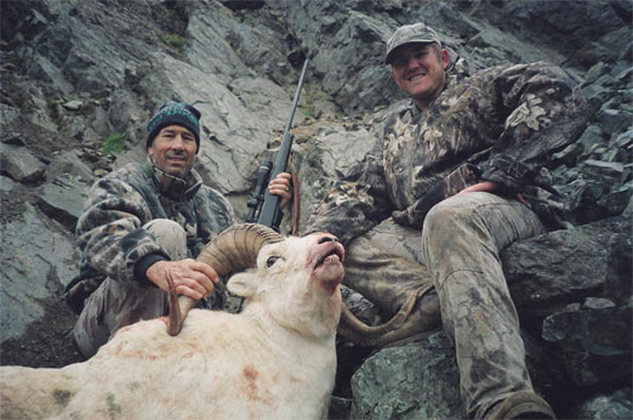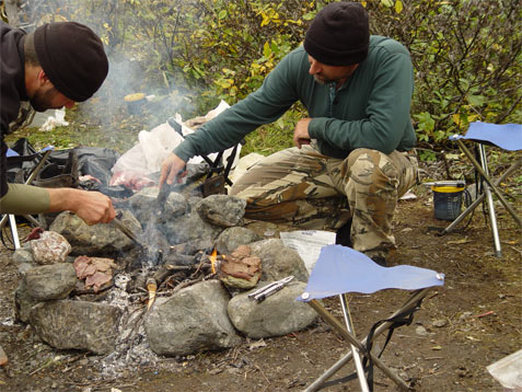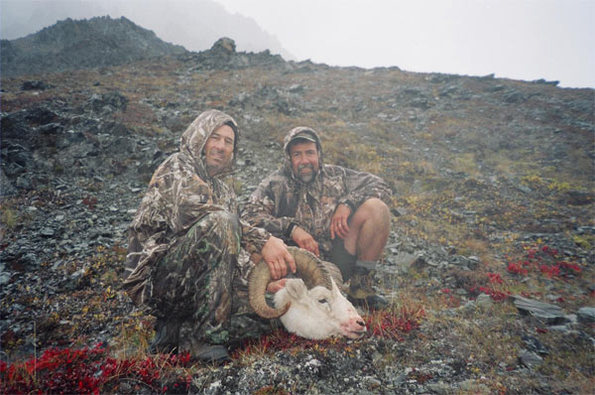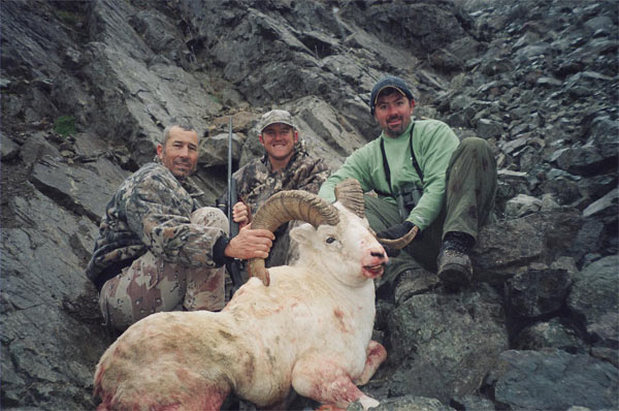The following is an account of one of our 2005 sheep hunts as told by Len Anderson. The father/son hunting team of Len and Dennis Anderson was guided by Derek Harbula and Jesse Ryder.
“Just don’t look back” we kept reminding ourselves as we spider crawled through the rocky chutes on 60 degree slopes. One missed step by any of the four of us would result in a helicopter evacuation to the nearest hospital. It was just another day in the glorious Chugach Mountains; hunting for the beautiful Dall Sheep that wake up to views of fall colors each September morning. Two thousand feet above camp, the furiously colored willows, alders, fire weed, and assorted berry bushes gave rise to the starkly different colored grays and blacks of glacial terrain that is marked by jagged crags, near vertical cliffs, rock slides, and loose footing. To make matters worse, the steady rain at camp had turned to blowing snow in the higher altitudes.
Our backpacks had been shed further down the slope to reduce the risk of hanging up on rocks that lined the narrow passageways. The two rams were there somewhere; we had previously glassed them from camp hours before and when we periodically peeked over knife-like ridges while picking our way through the rocky spires. But now, as we huddled on an impossibly steep slope, our backs to the snow, we could only guess where the rams had moved to. Derek, veteran sheep hunter and assistant guide, assured the rest of us that undisturbed rams in the rocks can suddenly appear while they feed. He advised that we should be patient and stay put. Five minutes later, like ghostly apparitions, a snowy image materialized from behind the opposite ridge. First, just the white of its back and then, the magnificent horns of a mature, full curl ram. The four of us immediately flattened out on the rocky slope to avoid detection. Boots, elbows, and fingernails dug in to keep us from sliding backwards and, shoulder to shoulder, we crawled to the crest of the serrated ridge; seemingly glued to the ground and hanging on with hands that weren’t occupied with binoculars. The second ram then appeared, horns flared wide, staring us down, wondering why his back yard didn’t look the way it did the day before. After a long, torturous minute, the second ram turned his attention away from us. Evaluations of horn length and numbers of growth annuli began, and we whispered opinions to each other. Could both of them be full curl rams? Could my boy and I whack two trophies simultaneously? Ultimately, it was Derek’s decision on the legality of each ram. The first one was definitely a full curled ram with heavy horns. The wide horned ram wouldn’t make it on length but possibly on age. However, the snowy conditions prevented Derek from being able to accurately count rings. It was just too risky of a call from 180 yards. Derek gave the green light for the full curled ram on the right, and my 7 mm Remington Magnum, seemingly radar locked on the ram’s near front shoulder, sent the 160 grain Barnes X bullet on its way.
What transpired next will be forever etched into each of our memories. The big ram, dead instantly, fell to the next ledge 15 ft. below, bounced and then somersaulted several times through space and out of our sight. All we could do was listen to the ram crashing down the rock slide. Fearing a badly scarred face and envisioning splintered horns, we gingerly picked our route down to the ram. Jesse was the first to reach the downed animal and announced that his horns had miraculously survived the 170 yard fall and would make a beautiful mount. It had been a grueling five hour climb and stalk. After the handshakes and picture taking, the real work of caping, salvaging meat, and making the long trek back to camp began. In September, darkness in the Chugach isn’t a factor until about 8:30 pm and four tired men were able to get the ram back to camp in the daylight. Mountain House freeze dried dinners never tasted so good.

The next morning, we were back at it again; trying to find a ram for Dennis. A big black bear had been spotted feeding in the blueberries about 2000 ft. above camp but Dennis was intent on finding a Dall ram to accompany the Desert Bighorn he took 11 years earlier when he was just 16 years old. Moon Valley (so named because of its characteristic landscape) was our targeted hunting area. We knew of a potentially legal ram that had been seen in the same general area as the other two rams. It would be another torturous climb; three hours, mostly side hilling and angling up through the rocky scree, until we could gain enough altitude to glass up the ram. He was a loner and was bedded in full view amongst the rocky spires but a piece of the mountain was shielding a view of his horns and we were unable to evaluate him. Using the shield to our advantage, we made our way up a steep, rock slide to the base of the near vertical cliffs. With the ram out of view, another daring climb through the rock chutes awaited the four of us. It was eerily similar to the situation encountered the previous day. We peeked over the edge of the steep ridge to assess our position. Although we were getting closer, we still could not see the ram. Our backpacks came off and we discussed whether we should creep forward through the narrow chutes or drop down to the base of the cliffs and work our way around or just stay put. Derek’s unspoken decision to stay where we were paid off ten minutes later when, like magic, the big ram sky lined himself on top of a rocky spire; a majestic, white symbol of all that is beautiful in the Chugach Mountains. Derek quickly judged the ram as full curl and ranged him at 292 yards. Dennis scrambled to the ledge, centered the cross hairs, but pulled right and missed the shot. It was his only shot as the ram quickly vanished as easily and magically as he had appeared. To be sure of a miss, we reviewed the shot in Jesse’s video camera and then climbed down to gain a more favorable glassing position. However, after 1 ½ hours, we were unable to catch a glimpse of the big ram. He simply had disappeared in the maze of boulders and narrow canyons.
Dejected, we started the long trip back to camp, silently cursing the missed opportunity and secretly wondering how we would muster the energy to make another brutal climb the next day. After crossing the nasty rock slide that characterizes Moon Valley, Dennis spotted a black bear high above camp. Although the bear was nearly a mile and three big ridges away, it was apparent that he had a beautiful, jet black hide, and we all assumed it was the same large bear Tony had seen that morning. It was Dennis’ decision; he could use his ram tag on the bear or he could keep hunting for a big ram. With poor weather forecasted and a limited number of days before the conclusion of the season, Dennis opted for the bear. The blackie was feeding in the blueberries when we started the long stalk. About 30 minutes later, we had made our way to the opposite ridge, putting us within shooting range of the bear. The bear had finished his feeding session, had lumbered into the rocky bottom separating the two ridges, and was making his way up the slope occupied by the four of us. Dennis and the bear saw each other simultaneously, causing the bear to whirl around and try to escape by scaling the opposite ridge. With Jesse filming the action, Dennis shouldered his 7 mm Rem. Magnum and this time, he didn’t miss. It was not the large, 300 lb bear that was seen that morning, but he had a beautiful pelt and will be forever remembered.
Although we had to dodge raindrops, that night we enjoyed some fine cuisine known as “rock mutton”. Heat up a flat rock (either by backpack stove or by campfire); sprinkle some Top Ramen spices on butterflied sheep steaks that have been situated on the rock; and turn as needed. What a delicacy!! A Tony Dingess and Derek Harbula specialty!!

Our thanks and appreciation goes out to Tony for organizing the hunt. As for Derek and Jesse……these are two of the hardest working, toughest men in the business, and we appreciate their love of hunting and wildlife. Thanks for pulling off three great stalks!!
Len Anderson

Thanks to Len and Dennis both for enduring a tough hunt, and having patience, which is so often the critical key in Alaska hunting. Thanks of course go out to my Assistant Guide Derek Harbula (take note that Derek still can’t afford to buy a pair of pants, even for September sheep hunting!) and apprentice Jesse Ryder for staying the course when it counts.
